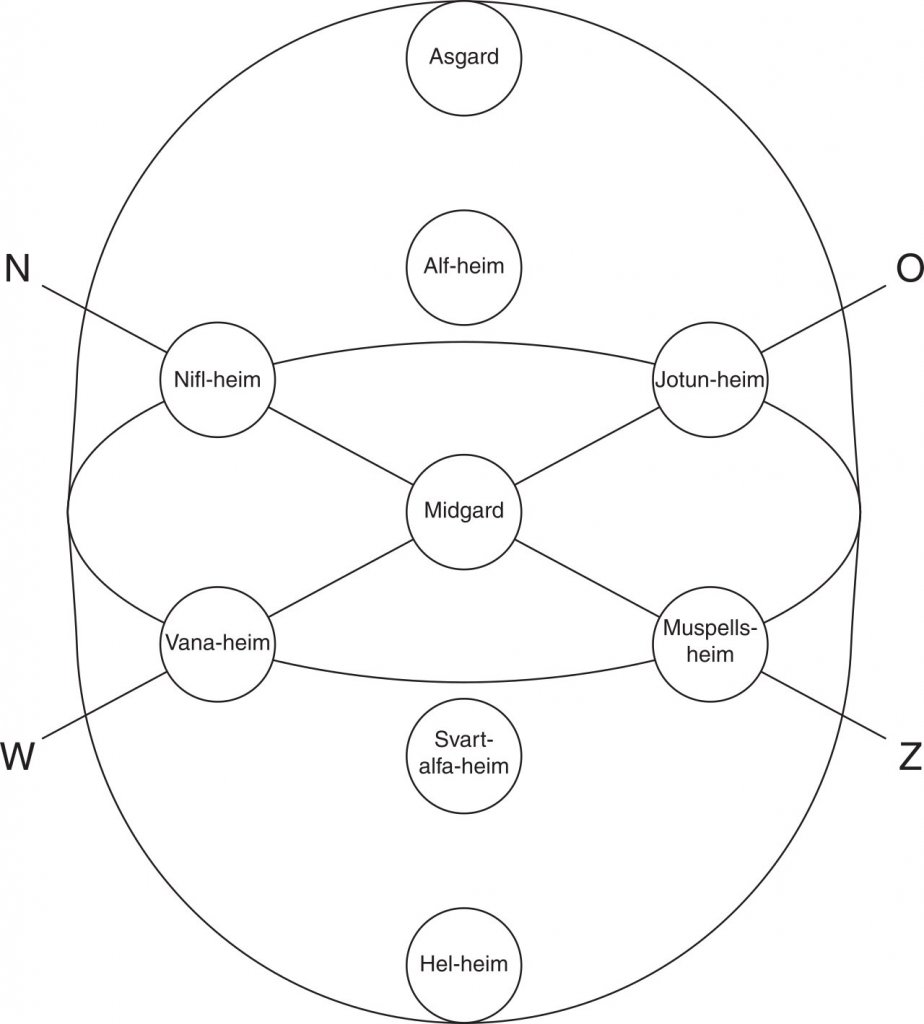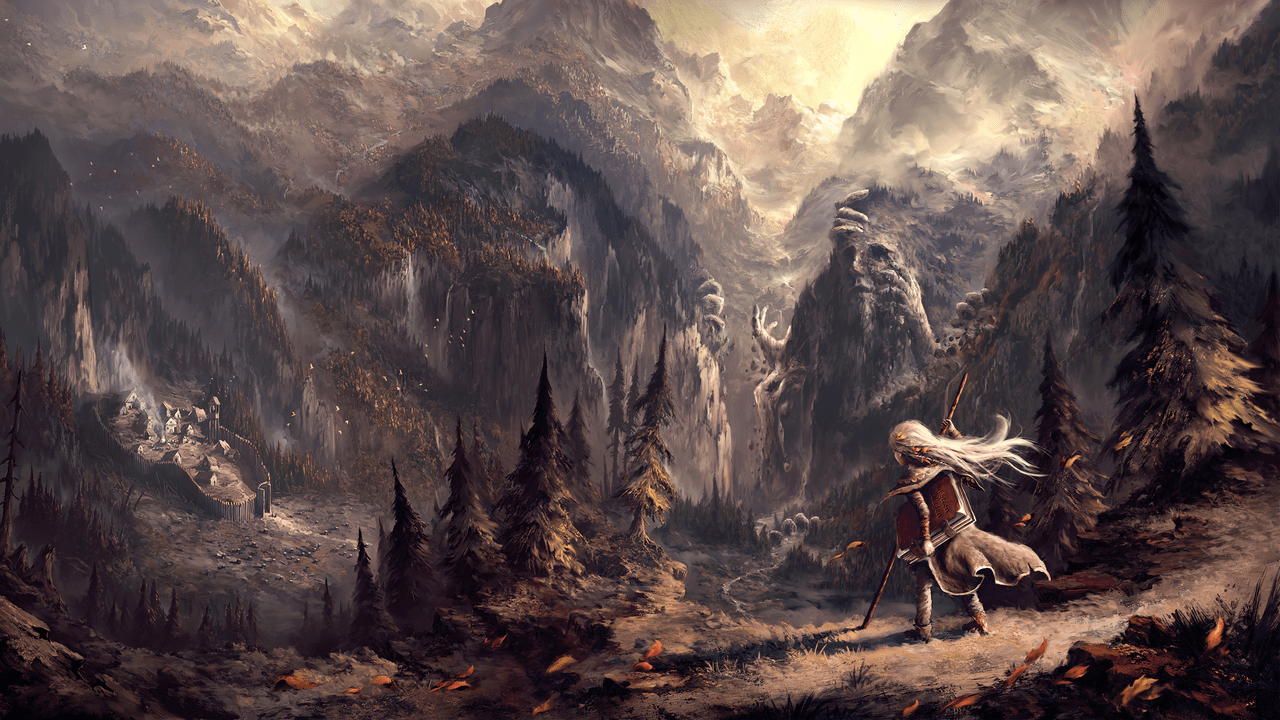Norse cosmology divided the universe into nine realms, with the great world tree Yggdrasil at its center. Some domains sat in the branches, with the remainder lying underneath the roots in a row. Vanaheim sat among the highest levels of the world tree next to Asgard and Alfheim.
The Origins of Vanaheim
There are attestations of Vanaheim (also known as Vanaheimr) in the Poetic Edda, a 13th-century compilation of works using earlier, traditional sources. They also appear in the Prose Edda and the Heimskringla, 13th-century works by the Islandic politician, historian, and poet Snorri Sturluson.
Indeed, some scholars claim that Sturluson invented Vanaheim. However, an original Old Norse poem mentions the realm by name, and we can be relatively sure Vanaheim was a genuine part of Old-Norse mythology.
Popular opinion often claims that Norse mythology cites opposites of geographical regions and psychological states as “Innangarðr“ (Innangard) or “Útgarðr (Utangard). “ “Innangarðr” means “within a fence,” and “Útgarðr“ means “outside a fence.” The idea is that somewhere, “Innangard“ is controlled, peaceful and serene, while something “Utgard” is hostile, wild, and anarchic.
Two of the nine realms are Innangard, Asgard, and Midgard. Because these lands contain “gard” in their name, we can suppose they are inside a fence and therefore possess an element of control.
The other seven realms end in “heim” (or home) and would indicate lands of a wilder nature in terms of their inhabitants and environment.
As we will see, some sources may contradict this theory because they depict Vanaheim as fertile land suitable for agriculture and fishing.
What is Vanaheim The Realm Of?
According to Norse cosmology, Vanaheim is the realm of the Vanir, gods associated with soothsaying, fertility, magic, and wisdom.
Vanaheim is described as where the god Njord (or Njörðr) was born and grew up. Njord is primarily associated with the sea but is also linked to fishing, wind, crop fertility, and wealth.
Vanaheim is a mystery because no descriptions of the land exist in any known literature. However, Rudolf Simek, producer of some notable works on Norse mythology, believed it suited perfectly to agriculture and fishing.
He writes:
The Vanir are in particular fertility gods who were called upon for good harvests, sun, rain, and good winds especially by the agrarian population, and for favorable weather conditions by the seafarers and fishermen.
Nine Realms of Norse Cosmology – World History Encyclopedia
Who Is the King of Vanaheim?
Before the war of the gods, Njord was the ruler of Vanaheim, although he wasn’t actually called a king.
Njord was the father of the gods Freyr and Freyja (daughter of his unnamed sister and mother of Frigga) and had an ill-fated marriage with the goddess Skadi. Njord lived in Nóatún, Vanaheim, described by Sturluson in the Prose Edda book of Gylfaginning as being in heaven.
As explained below (section ‘What Happened to Vanaheim’?), Hœnir became the first king of Vanaheim, although his reign was short-lived. The subsequent rulers had relative autonomy thanks to the influence of Frigga and the legacy of the Æsir-Vanir War.
Is Vanaheim in Asgard?
As we’ve already seen, clear information about Vanaheim and its location is not present in many old Norse works of literature.
However, the Poetic Edda does state the Vanir god Njord was taken east as a prisoner at the end of the Æsir-Vanir War. We can therefore conclude that Vanaheim is somewhere west of Asgard.
Chapter one of the Ynglinga saga in the Heimskringla says “Van Home or the Home of the Vanir” was near the Don River in Russia (which Sturluson referred to as the fork of “Tana” or “Vana”).
Chapter 15 describes king Sveigðir marrying a woman called Vana in Vanaland, Sweden.

What Happened to Vanaheim?
Asgard invaded Vanaheim over the incestuous practices of the Vanir.
Njord had fathered the goddess Freyja with his sister, and this incest outraged the Asgardians. Freyja also practiced a form of magic called seidr, which has associations with effeminacy, something some Asgardians found worthy of mockery.
Loki taunts Odin for his use of the magic in the Lokasenna. These magical practices may also have provoked Asgard into attacking Vanaheim.
You can read some accounts of the conflict in the Völuspá, a poem contained in the Poetic Edda or the Codex Regius and the Skáldskaparmál, found in the Prose Edda. There is also a record in the 13th-century Ynglinga saga from Heimskringla by Sturluson.
Two stanzas from the Völuspá may indicate that the war may have started after Gullveig came to Odin’s hall in Asgard, stabbed by spears, and burnt three times, coming back to life on each occasion.
On her third reincarnation, she took the identity of Heiðr. Gullveig is depicted as a witch or völva (or seeress – a sorceress and soothsayer) and often associated with gold.
Gabriel Turville-Petre, John Lindow, and Simek have postulated the theory that Gullveig/Heiðr is the same figure as Freyja.
Heimskringla
Subsequent stanzas mention the failure of peace talks between Vanaheim and Asgard and the beginning of the war. According to chapter four of Heimskringla, it was closely contested, despite Odin assembling a massive army of Asgardians.
The Vanaheim fought fiercely, and conflict raged across Asgard and Vanaheim, with the chapter describing the damage sustained to both lands.
Eventually, the two sides declared a truce and agreed on an exchange of hostages. According to chapter 23 of Gylfaginning, Vanaheim sent its most important people to Asgard: Njord, Freyr, and Freya were exchanged for Hœnir, whom the Vanir thought would be a great leader. Asgard also exchanged the sage Mímir for Kvasir, who Sturluson described as the wisest man in Vanaheim.
Hœnir became the king of Vanaheim and appointed Mímir, his advisor. It soon became apparent that the chief could not make any decisions on his own, always answering “let others decide” when asked to make a ruling without Mímir by his side to advise him.
The Vanir felt cheated by the exchange and, rather than making an example of Hœnir, beheaded Mímir instead and sent the head to Asgard.
Diar
Odin embalmed the head with herbs and used enchantments to give it the power of speech and reveal Mímir’s secrets. Odin gave Njord and Freyr command of sacrificial customs, and they became known as Diar (or gods) of Asgard. Freyja was the high priestess of these sacrifices and is credited with introducing seidr to Asgard.
Vanaheim is only mentioned once in the Poetic Edda; in a stanza of the poem Vafþrúðnismál. In Vafþrúðnismál, Odin, disguised as Gagnráð, engages in a contest of wits with the jötunn Vafþrúðnir. Gagnráðr asks Vafþrúðnir where Njord came from, as although he rules over hofs (courts) and hörgrs (altars), he did not grow up among the Æsir.
Vafþrúðnir answers by saying “wise powers” created Njord in Vanaheim and mentions his exchange as a hostage after the Æsir-Vanir War. Vafþrúðnir also predicts that Njord will return to the “wise Vanir” after Ragnarök (the Norse “end of days”).

